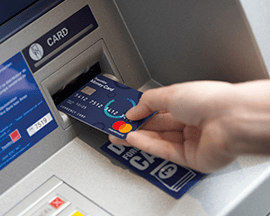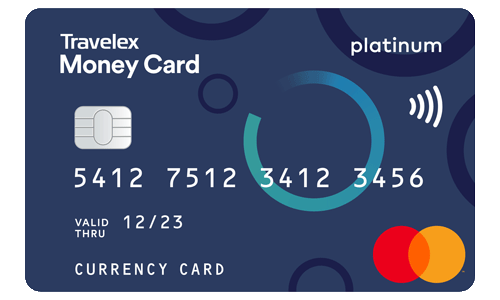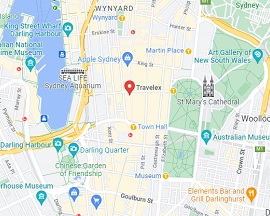How Much Spending Money For Europe?
Plan your Europe travel budget and get the right mix of euro currency before you go.
A European holiday is a classic trip for many Australians. It offers history, epic architecture, beaches, mountains, food, culture, and art. While the euro (EUR) is the dominant currency in Europe, not every country in the continent uses it. This means that things can get a little confusing when it comes to money matters.
The currency used in the majority of Europe is known as the euro. It is also abbreviated as € or EUR.
The euro was first launched in 1999 and aimed to unify countries in the European Union both monetarily and economically. The second phase of the euro adoption occurred in 2002, when euro coins and banknotes were created and distributed. This meant that the euro replaced national currencies such as French francs, Italian lira, Deutsche marks, and Dutch guilders.
The euro single currency is managed by the Economic and Monetary Union (EMU), which also coordinates Europe’s economic and fiscal policies.
- Currency: euro
- Currency code: EUR
- Central Bank: European Central Bank
- Currency symbol: € (euro)
- Currency sub unit: c (cent)
- Bank notes: €5, €10, €20, €50, €100, €200, €500
- Coins: 1c, 2c, 5c, 10c, 20c, 50c, €1, €2
If you're travelling to Europe, chances are you'll be using the euro (€).
Known by its currency code EUR, the euro is the official currency of most countries in the European union and the second most traded currency in the world—just behind the US dollar.
The euro was designed to simplify cross-border travel and trade, making it easier to budget, exchange and carry money while moving between countries.
It was introduced in 1999 and rolled out in physical form in 2002, replacing several countries’ own currencies — including the French franc, Italian lira and German mark.
Today, the euro is managed by the European Central Bank. You’ll find eight euro coins (from 1 cent to €2) and seven euro banknotes (from €5 to €500) in circulation throughout the eurozone.
Where are euros used in Europe?
| Non-EU members that use the euro: | ||
|---|---|---|
| Andorra | Monaco | San Marino |
| Kosovo | Montenegro | Vatican City |
| EU members that do not use the euro: | ||
|---|---|---|
| Bulgaria | Denmark | Sweden |
| Hungary | Czech Republic | Poland |
Euro denominations
Euro currency includes eight coins and seven banknotes, with standardised denominations used across all eurozone countries. Understanding these will help you avoid confusion at the checkout—and make sure you’re carrying the right mix of euro cash.
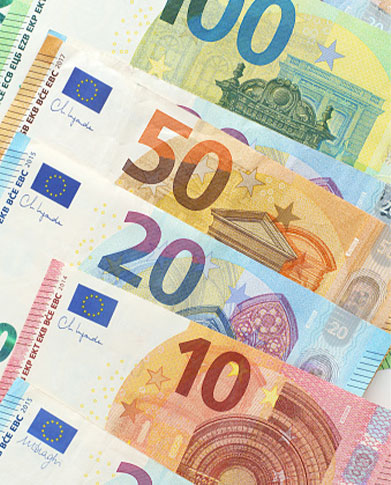
Euro banknotes
European banknotes are used for everyday purchases and larger payments alike — from groceries and museum tickets to high-end restaurant meals.
The most commonly used euro banknotes are €5, €10, €20, €50 and €100.
While €200 and €500 notes also exist, they’re less frequently used due to their high value.
Euro coins
Euro coins come in eight denominations: 1c, 2c, 5c, 10c, 20c, 50c, €1 and €2. Each coin has a common side (representing the EU) and a national side that varies by country.
Coin sizes increase with their value, making them easy to tell apart.
They’re often used for smaller purchases, transport tickets, or kept on hand as everyday loose change.
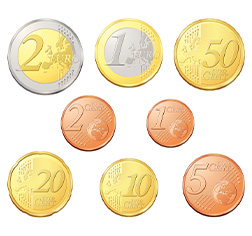
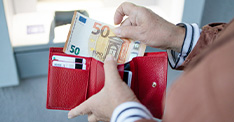
Payment options in Europe can vary greatly depending on which country you visit. In general, credit cards and travel cards are widely accepted, however, having cash on hand may also be required. There are ATMs all over central city areas in Europe which you can use during your travels to obtain cash.
European Coins and Notes
Cash in the form of euro notes and coins can be useful to have when travelling around Europe, especially in more rural areas. Rural European districts such as Aurich in Germany and Metsovo in Greece are still largely cash-based with few card or online payment options.
As a result, it’s always good to be prepared and have cash on hand, especially if you are planning on visiting the European countryside, where establishments only accept payment in cash. You can obtain cash by visiting an international ATM in any major European city and using the Travelex Travel Money Card to withdraw coins and notes.
Best Travel Cards for Europe
Having a travel money card makes exploring Europe easy and convenient. Not only will you have access to money 24/7, but you can also exchange currency whenever you like. If you are visiting major European cities such as Paris, Rome, and Berlin, you can use the Travelex Travel Money Card to pay for most, if not all, of your purchases.
The Travelex Travel Money Card is an award-winning global currency card designed for the savvy traveller. It can store multiple foreign currencies at once, including the euro, and can be used wherever Mastercard is accepted.
For extra convenience during your travels, you can also keep track of the euro exchange rate with the Travelex currency converter or travel rate checker. The currency converter allows you to find the live euro rate and compare it with past rates against another common currency.
How much you’ll need for Europe depends on a few things—how long you're going, which countries you're visiting, and your travel style.
However, most Aussies spend anywhere from $6,000 to $15,000+ on a Europe trip.
Flights from Australia typically cost between $1,200 and $2,000 return. Once you’re there, spending money in Europe usually ranges from $100 to $200 per day, covering food, transport, activities, and extras.
To help you budget smarter, below is a breakdown of average travel prices across Europe.
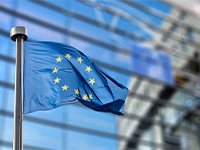

Food & dining costs in Europe
Food in Europe ranges from ultra-affordable to fine-dining pricey.
Southern and Eastern Europe (think Portugal, Croatia, Italy) are generally cheaper, while Western and Nordic countries (like Switzerland and France) tend to cost more.
Tip: Local cafés, markets and street food can help keep your food budget in check—especially in bigger capital cities like Rome or Barcelona.
| Foods in Europe | Average Cost in EUR |
|---|---|
| Standard meal | € 9.00 - 18.00 |
| 2-person three course meal | € 40.00 - 72.20 |
| Coffee< | € 1.45 - 3.55 |
| Beer | € 2.00 - 5.00 |
Transport costs in Europe
Transport is where Europe shines: it's well-connected, efficient, and often budget-friendly. Whether you're hopping on public transport or hiring a car, here’s what you might pay.
Tip: Rail passes like the Eurail Pass can save your spending money if you’re planning multiple train trips across the continent.
| Transport in Europe | Average Cost in EUR |
|---|---|
| One-way public transport ticket | € 1.70 - 3.00 |
| Monthly public transport pass | € 40.00 - 75.00 |
| Taxi (per 1km) | € 0.80 - 2.90 |
| Car hire (per day) | € 7.00 - 40.00 |


Europe attractions & activity prices
Europe is packed with cultural, historic, and bucket-list experiences. Whether you're visiting famous museums or sailing on a Venetian gondola, costs can add up.
Tip: Many cities offer tourist passes (like the Paris Museum Pass or Roma Pass) that bundle major attractions and offer big savings.
| Entertainment Activities in Europe | Average Cost in euro |
|---|---|
| Museum admission | € 25.00 – 50.00 |
| Hot air balloon ride | € 171.00 - 250.00 |
| Water taxi | € 100.00+ |
Wi-Fi & sim card costs
Free Wi-Fi is common in hotels, restaurants, and transport hubs—but for reliable access across borders, a prepaid international SIM is the way to go. Explore Europe eSIMs.
Travelex partners with Simify to offer affordable eSIMs for European travel.
Tip: eSIMs are hassle-free—no swapping cards, just scan and go. Perfect if you're hopping between countries.
| Plan | Duration | Countries | Price (AUD) |
|---|---|---|---|
| Unlimited Europe and & UK eSIM | Up to 90 days | 43 | From $44 |
| Europe and & UK eSIM (up to 100GB) | Up to 90 days | 43 | From $25 |


Europe visa costs (Schengen visa)
If you’re travelling to Europe for less than 90 days within any 180-day period, you generally won’t need a visa (Australians included).
But if you’re staying longer or planning work/study, you’ll need a Schengen visa.
Note: Visa requirements can vary depending on your itinerary and travel history—always check with the embassy of your destination before booking.
| Applicant | Cost (EUR) |
|---|---|
| Adults | € 80 |
| Children (6-12 years) | € 40 |
| Children (under 6) | Free |
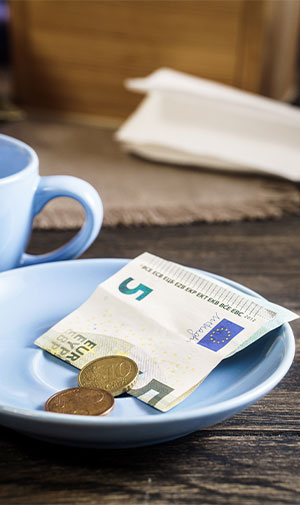
Europe is made up of many countries and cultures, and monetary customs can change from country to country. Keep the following customs in mind on your travels for smooth sailing:
While tipping is generally appreciated in most of Europe, services are included in the bill in Scandinavian countries like Sweden, Finland, Iceland, and Denmark.
If you’re travelling to destinations like Greece and plan on buying small souvenirs make sure you keep smaller denominations on hand, as store holders often do not have change for larger notes.
When using your ATM card in Europe, you will be required to know your 4-digit pin code.
You may find that some countries that do not officially use the euro still accept it in touristy areas. This includes Albania, Poland and in the Czech Republic, however it is recommended that you take local currency with you.
American Express cards may not be as readily accepted in stores throughout Europe due to their high merchant charges.
Don’t forget to consult our Europe Travel Checklist for some more extra tips before you depart!
European Countries and the Euro
| EU members that use the euro: | ||
|---|---|---|
| Austria | Greece | Netherlands |
| Belgium | Ireland | Portugal |
| Croatia | Cyprus | Italy |
| Estonia | Latvia | Slovenia |
| Finland | Lithuania | Spain |
| France | Luxembourg | Slovakia |
| Germany | Malta | |
| Non-EU members that use the euro: | ||
|---|---|---|
| Andorra | Monaco | San Marino | Kosov | Montnegro | Vatican City |
| EU members that do not use the euro: | ||
|---|---|---|
| Bulgaria | Denmark | Sweden |
| Hungary | Czek Republic | Poland |
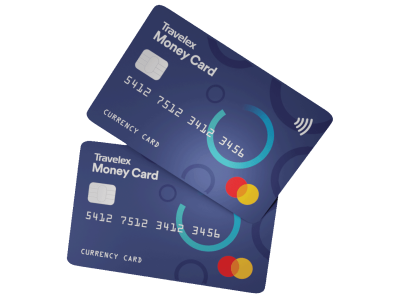
- Holds up to 9 available currencies
- Use your card globally wherever Mastercard is accepted
- Manage your card via the Travel Money App
- Buy online and collect in-store or walk in store
Europe can be as affordable or pricey as you make it. On average, budget travellers might spend around AUD 100 per day, while mid-range trips often cost AUD 150–250 daily. Using euro cash wisely and choosing the right currency exchange options, like Travelex, can help you manage your Europe spending money effectively and avoid high fees.
A mix of euro cash, prepaid travel cards, and credit/debit cards works best. Use euro cash for small purchases, tips, and rural areas. Travelex Travel Money Cards lock in exchange rates and offer security. Credit cards cover hotels and bigger expenses but watch for foreign transaction fees.
Explore Travelex’s EUR Cash & Travel Card Bundle.
Eastern European countries like Poland, Hungary, Slovenia, and the Czech Republic offer great value for Australian travellers. Your spending money goes further on food, transport, and accommodation compared to pricier destinations like Italy, Germany, or the Netherlands.
If you’re planning to visit countries that don’t use the euro—like Hungary or Poland, it’s worth budgeting for local European currency in addition to euro banknotes for stops in places like Spain, Greece, or Belgium.
Twenty European Union countries use the euro as their official currency. Remember, euro currency is generally not accepted outside these countries. If you travel between euro and non-euro nations, you’ll need to exchange cash accordingly—Travelex offers easy currency exchange solutions for your Europe travel needs.
Buying euros before you fly, especially with Travelex, can help you lock in a great euro exchange rate, avoid airport markups, and have euro currency in hand for immediate expenses like taxis and tips.
For more info, check out our Buying Tips.
France uses the euro (€) as its official currency. Travelling in France means you'll need euro banknotes and coins for purchases, small vendors, and tipping.
Learn more about Buying Euros For France.
Yes, Spain uses the euro as its official currency. If you’re visiting Spain, make sure you carry some euro cash for markets, local transport, and tipping, alongside your cards. Travelex makes buying euros easy, whether in Australia or at European locations.
Learn more about Buying Euros For Spain.
Travel insurance costs vary but typically range from AUD 100 to AUD 300, depending on coverage and trip length. Travelex partners with Cover-More to offer tailored travel insurance plans with 24/7 emergency support and coverage for financial losses, helping you travel Europe worry-free.
Tipping customs vary, but generally, tipping 5–10% is appreciated in Europe. Cash tips are common, especially for taxis, restaurants, and guides. Note: Scandinavian countries like Sweden and Denmark usually include service charges in bills, so tipping is less common there.
The shoulder seasons—spring (April to June) and autumn (September to October)—are the most affordable times to travel Europe. Flights tend to be cheaper, crowds smaller, and euro currency goes further in off-peak months.
For more advice on travelling to Europe, read our Europe Travel Checklist Guide.
Is Europe expensive for Australians?
Europe can be as affordable or pricey as you make it. On average, budget travellers might spend around AUD 100 per day, while mid-range trips often cost AUD 150–250 daily. Using euro cash wisely and choosing the right currency exchange options, like Travelex, can help you manage your Europe spending money effectively and avoid high fees.
What's the best way to pay for things in Europe?
A mix of euro cash, prepaid travel cards, and credit/debit cards works best. Use euro cash for small purchases, tips, and rural areas. Travelex Travel Money Cards lock in exchange rates and offer security. Credit cards cover hotels and bigger expenses but watch for foreign transaction fees.
Explore Travelex’s EUR Cash & Travel Card Bundle.
What are the most affordable countries in Europe?
Eastern European countries like Poland, Hungary, Slovenia, and the Czech Republic offer great value for Australian travellers. Your spending money goes further on food, transport, and accommodation compared to pricier destinations like Italy, Germany, or the Netherlands.
If you’re planning to visit countries that don’t use the euro—like Hungary or Poland, it’s worth budgeting for local European currency in addition to euro banknotes for stops in places like Spain, Greece, or Belgium.
How many countries use the euro?
Twenty European Union countries use the euro as their official currency. Remember, euro currency is generally not accepted outside these countries. If you travel between euro and non-euro nations, you’ll need to exchange cash accordingly—Travelex offers easy currency exchange solutions for your Europe travel needs.
Is it better to buy euros in Australia or Europe?
Buying euros before you fly, especially with Travelex, can help you lock in a great euro exchange rate, avoid airport markups, and have euro currency in hand for immediate expenses like taxis and tips.
For more info, check out our Buying Tips.
What currency is used in France?
France uses the euro (€) as its official currency. Travelling in France means you'll need euro banknotes and coins for purchases, small vendors, and tipping.
Learn more about Buying Euros For France.
Does Spain use euros?
Yes, Spain uses the euro as its official currency. If you’re visiting Spain, make sure you carry some euro cash for markets, local transport, and tipping, alongside your cards. Travelex makes buying euros easy, whether in Australia or at European locations.
Learn more about Buying Euros For Spain.
How much is travel insurance to Europe?
Travel insurance costs vary but typically range from AUD 100 to AUD 300, depending on coverage and trip length. Travelex partners with Cover-More to offer tailored travel insurance plans with 24/7 emergency support and coverage for financial losses, helping you travel Europe worry-free.
Do you tip in Europe?
Tipping customs vary, but generally, tipping 5–10% is appreciated in Europe. Cash tips are common, especially for taxis, restaurants, and guides. Note: Scandinavian countries like Sweden and Denmark usually include service charges in bills, so tipping is less common there.
What's the cheapest time to travel to Europe from Australia?
The shoulder seasons—spring (April to June) and autumn (September to October)—are the most affordable times to travel Europe. Flights tend to be cheaper, crowds smaller, and euro currency goes further in off-peak months.
For more advice on travelling to Europe, read our Europe Travel Checklist Guide.
